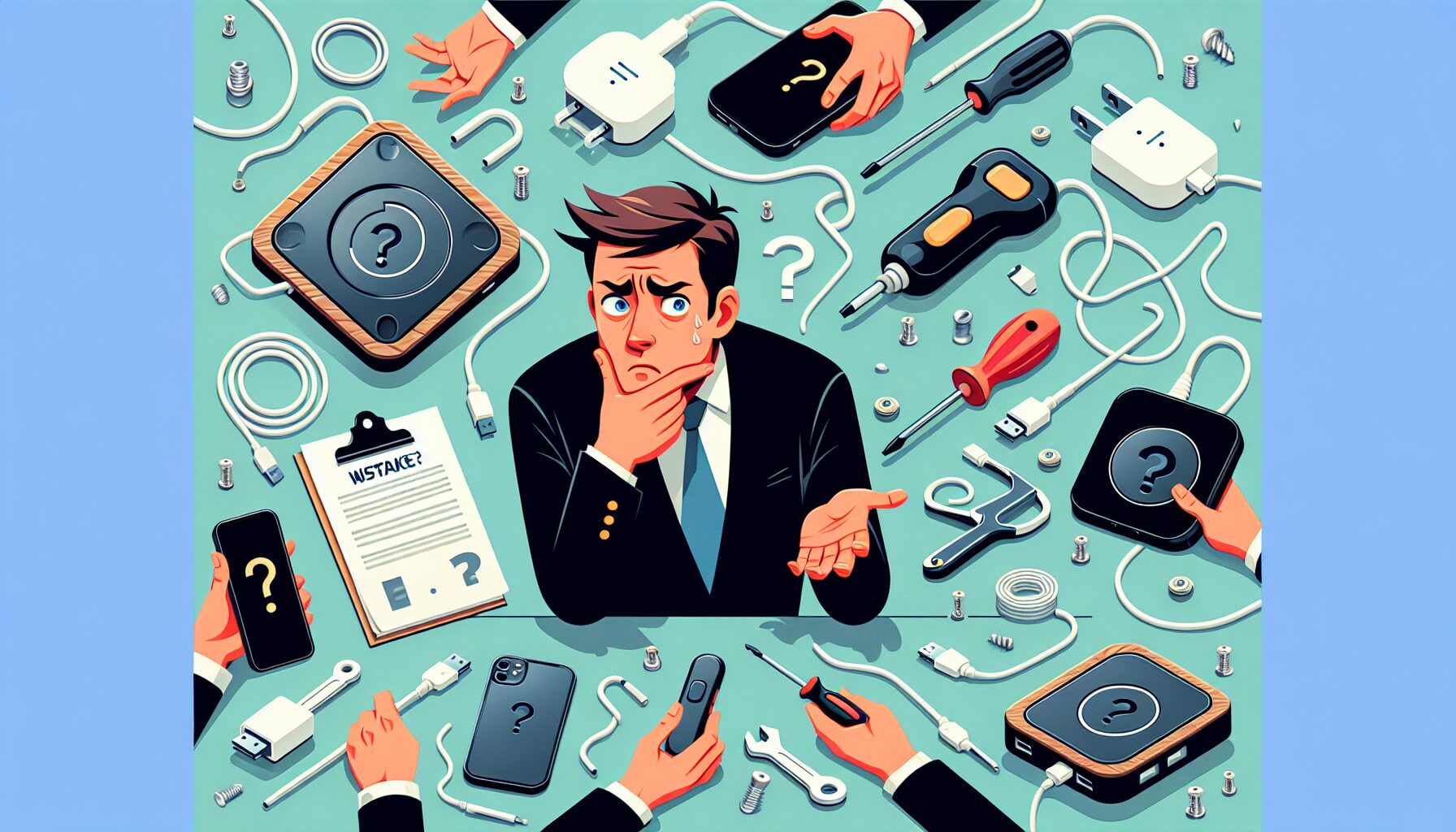Oh, the joy of setting up a wireless charger, right? But, let me tell you, there’s more to it than just plugging it in and placing your phone on top. One afternoon, I was super excited to test my new charger, only to find it didn’t work. It turns out, my device wasn’t compatible with the Qi standard, which is the universal standard for wireless charging. Who knew? If your phone doesn’t support this, you might be out of luck. Additionally, you need to be aware of electromagnetic interference. This can mess with the charging process. I once used a multimeter to check for voltage issues because I was getting inconsistent charging. It turned out that interference was the culprit! Companies like Wireless Power Consortium provide valuable resources on compatibility. Always check if your chargers and devices are Qi-certified to avoid any headaches.
Related: The Ultimate Guide to Wireless charging technology for electric cars
Choosing the Right Location for Your Charger
Finding the perfect spot for your wireless charger can be a bit like setting up a cozy nook in your home. You want it to be convenient but also functional, right? When I first got my hands on a Qi wireless charger, I was super excited but also a little clueless about where to place it. I made the mistake of positioning it near my kitchen appliances. Big no-no! Electromagnetic interference from those appliances can really mess with the charging process. A multimeter can be handy to test for voltage consistency and ensure you’re getting the best performance from your charger.
However, choosing the right location isn’t just about avoiding interference. It’s also about accessibility and safety. Keeping your charger in a high-traffic area might seem practical, but it could lead to accidents. You don’t want someone accidentally knocking it over or tripping over the cables. Instead, consider placing it on a bedside table or a dedicated desk space. These spots are usually less chaotic and more stable.
Considerations for Optimizing Wireless Charging
Additionally, think about the surface material. Metal surfaces can reflect electromagnetic fields, which could interfere with charging. Wood or plastic surfaces are ideal choices. Also, remember that direct sunlight can heat up your device, affecting the battery’s longevity. Therefore, a cool, shaded area is preferable. Furthermore, if you’re in a multi-device household, you might want to invest in a wireless charging pad that can handle multiple gadgets at once. This way, you can avoid the frustration of tangled cables and limited outlets.
Finally, don’t forget about ventilation. Devices can heat up while charging, so ensure there’s enough air circulation around the charger. This reduces the risk of overheating. With these tips in mind, you’ll avoid common pitfalls and enjoy seamless charging experiences. Oh, and if you’re curious about more tech insights, check out Canadian Wireless Telecommunications Association for more detailed guidance on wireless tech and its applications in Canada.
Avoiding Common Installation Errors

Let me tell you, when I first tried setting up a wireless charger, it was a comedy of errors! I remember being so excited to try out the Qi wireless charging standard, only to realize I hadn’t checked for electromagnetic interference (EMI) shielding. This is crucial because EMI can disrupt the charging process, causing your phone to charge slower or not at all. It’s like trying to fill a leaky bucket—you just won’t get the results you’re hoping for.
Another thing to watch out for is the thickness of your phone case. If it’s too bulky, it might prevent effective charging. This happened to me when I had a heavy-duty case on my phone. I was puzzled why my battery was still low after hours on the charger. So, always check the specifications of your charger to ensure it can work through thicker cases.
Check Your Power Source
Additionally, make sure you’re using a compatible power adapter. I once used an old adapter, thinking it wouldn’t make a difference. Boy, was I wrong! A wireless charger needs a specific power output to work effectively. Using a multimeter to test voltage can be a game-changer here. It ensures the adapter provides the necessary juice. According to Reuters, using the wrong power adapter is a common oversight. Therefore, double-check your equipment to avoid such mishaps.
If you’re installing a wireless charger in your car, be careful about placement. You don’t want it near metal objects that can cause EMI. I learned this the hard way when my GPS went haywire after mounting my charger near the dashboard. It’s always a good idea to keep these devices apart to avoid interference. And if you’re unsure, the Canadian Standards Association is a great resource for guidelines on safe installations.
Ensuring Effective Power Supply Connections
Let’s dive into the exciting world of wireless charging and make sure you’re getting the most out of your setup! One common hiccup folks encounter is ensuring that their power supply connections are up to snuff. Trust me, I’ve been there. A few months back, I was setting up my sleek new wireless charger. I was so thrilled until I realized my phone was charging at a snail’s pace. Turns out, I didn’t pay enough attention to the power adapter I was using. Big mistake!
First off, you’ve got to make sure you’re using a power adapter that supports the latest GaN technology. These adapters are not only more energy-efficient but also offer better performance. They handle high power levels without overheating, which is perfect for fast charging! This little detail can make a world of difference. I learned it the hard way, but you don’t have to.
Additionally, always ensure your Qi charging coil is aligned properly with your device. I remember my friend Sarah complaining about her phone not charging wirelessly. We found out her phone wasn’t sitting right on the charger, which was causing all sorts of issues. A little adjustment and voilà, her phone was charging like a charm! It’s these small tweaks that can save you a lot of frustration.
Managing Interference
Another key point is to manage electromagnetic interference. This can be a silent disruptor in your wireless charging experience. If you’ve got other electronic devices nearby, they could be causing interference. Make sure your charging spot is as clear as possible. You might also want to check out resources from Canadian Standards Association for guidelines on minimizing interference.
Finally, for those of you venturing into wireless charging for electric cars, make sure to explore our comprehensive guide on wireless charging technology for electric cars. It’s packed with insights! By taking these steps, you’re setting yourself up for a seamless and efficient wireless charging experience. Happy charging!
Troubleshooting Charging Performance Issues

Ah, wireless chargers! They’re so convenient, right? However, sometimes you might find your phone not charging as fast as it should. Trust me, I’ve been there. One evening, I noticed my phone barely charged after hours on a Qi wireless charger. So, I dove into the tech behind it. Did you know the Qi standard depends heavily on properly aligned coils? If they’re off even slightly, charging efficiency drops dramatically.
Another thing to watch for is electromagnetic interference (EMI). This can really mess with your charging. Make sure your charger has good EMI shielding. This is crucial, especially if you’ve got a lot of devices around. I once placed my charger near my router, and oh boy, it was a mess! Relocating it made a world of difference.
Understanding Power Delivery Protocols
Here’s a nifty detail: not all wireless chargers support the same power delivery (PD) protocol. If your charger isn’t PD-compatible with your device, charging will be slow. Check if both your charger and device support the same PD specifications. Additionally, ensure your charger is plugged into a high-quality power source. I’ve learned that using a low-wattage adapter can severely limit charging speed.
Also, don’t forget about software updates. Manufacturers like Apple and Samsung frequently release updates to improve charging efficiency. Updating your phone can sometimes solve performance issues. Lastly, keep your charging pad clean. Dust and debris can interfere with charging. A quick wipe can often do wonders for charging performance.
Maintaining Your Wireless Charging Setup
Maintaining your wireless charging setup is crucial for ensuring its longevity and efficiency. I remember setting up my first wireless charger and getting so excited, only to realize later that I hadn’t thought about how to keep it in tip-top shape. Trust me, it’s worth the effort! First off, make sure you’re using a charger that adheres to the Qi wireless charging standard. This standard ensures compatibility across a variety of devices, so you’ll avoid any compatibility hiccups.
Now, let’s talk about interference. Electromagnetic interference (EMI) can be a sneaky villain in wireless charging. It’s a good idea to keep your setup away from other electronic devices that might cause EMI. I once had my charger too close to my old radio, and it wreaked havoc on the charging efficiency. A little distance can make a big difference!
Testing and Troubleshooting
Don’t forget to regularly check the voltage output of your charger using a multimeter. This handy tool can help you ensure that your charger is delivering the correct power to your device. If the voltage is off, it might be time to replace your charger. I learned this the hard way when my phone started charging slower than usual. A quick test revealed the issue.
Furthermore, cleanliness is key. Dust and grime can accumulate on the charging pad over time, which might affect performance. Wipe it down with a soft, damp cloth regularly to keep it clean. Also, make sure your phone’s back is free of debris. It’s a simple step but super effective in maintaining optimal performance.
Additionally, be mindful of software updates. Sometimes, charging issues can be resolved with a quick update. Manufacturers like Apple and Samsung often release updates that include improvements in charging capabilities. Keep an eye out for these updates to ensure that your device is running smoothly.
Conclusion
In essence, mastering wireless charging is all about understanding compatibility, minimizing interference, and ensuring proper setup and maintenance. By paying attention to these details, you’ll not only enhance your charging experience but also prolong the lifespan of your devices. Remember to keep your charging area organized, clean, and up-to-date with the latest tech standards. With these insights, you’re well on your way to a seamless and efficient wireless charging journey. Enjoy the convenience and keep powering on!
Continue Exploring
Unlock the future of electric vehicles with the groundbreaking technology of wireless charging. Dive into the science that is reshaping how we power our rides, offering convenience and innovation like never before.
Frequently Asked Questions
What are the most common installation mistakes for wireless chargers in the home?
The most common mistakes include placing the charger on uneven surfaces, not checking compatibility with your device, ignoring manufacturer’s instructions, and installing near electronic interference sources like microwaves or large metal objects.
How can I avoid compatibility issues when setting up a wireless charger?
To avoid compatibility issues, ensure that both your wireless charger and device support the same charging standard, such as Qi. Check the manufacturer’s specifications for your phone and charger, and avoid using cases or accessories that may interfere with the charging signal.
Why is my phone not charging efficiently on the wireless charger after installation?
Inefficient charging may be due to misalignment between the charger and the phone, thick phone cases interfering with the charging signal, outdated charger firmware, or environmental factors like extreme temperatures. Ensure proper alignment and remove any barriers to optimize charging efficiency.


Leave a Reply